Although the use of chatbots is still relatively new, ecommerce is quickly becoming the biggest customer of this new technology. So, exactly what are ecommerce chatbots?
Simply put, an ecommerce chatbot is a type of artificial intelligence (AI) that simulates conversation with customers on an ecommerce site to answer questions, provide customer service, and facilitate simple actions.
This guide will look at the different types of chatbots, their uses in ecommerce, and the pros and cons of the new tech, as well as how you can add a chatbot to your ecommerce site.
Types of Chatbots
Before we get into how you can use ecommerce chatbots, it’s important to understand the different types at your disposal. In general, there are two types of chatbots: rule-based and conversational.
Did You Know?
According to a study from Juniper Research, the total number of chatbot messaging apps accessed globally is projected to increase by 169%, from 3.5 billion in 2022 to 9.5 billion by 2026. This growth will be driven primarily by ecommerce players and omnichannel retailers.
Rule-based Chatbots
Rule-based chatbots are the earliest type of chatbots. They operate on predefined rules and can only provide programmed responses. These chatbots are typically more limited in their capabilities than newer, conversational chatbots, as they can only answer predefined questions and provide preprogrammed responses. They are, however, generally less expensive than their conversational counterparts.
Conversational Chatbots
Conversational chatbots are the newest iteration of the chatbot and operate with a much more complex and intelligent technology than rule-based bots. Conversational chatbots use AI and natural language processing (NLP) to understand and answer customer questions and continue learning from interactions they have with users. This ongoing learning allows them to improve from their initial configuration in terms of both conversation skills as well as problem resolution.
Conversational chatbots can identify the language, context, and intent and then react accordingly. This means that conversational bots can understand and provide answers to questions they have never seen before.
Ecommerce Chatbot Uses
Chatbots have unique uses in ecommerce that we will explore below. It is important to note the chatbots are very customizable, and your chatbot can be programmed to do all or none of the functions below. Additionally some chatbots don’t have the capabilities to perform certain processes, so you should know what you want your chatbot to do as you are looking at different options.
1. Providing Customer Service
With ecommerce chatbots, a customer can report product issues, shipping delays, and more. The chatbot can provide resolutions to customer problems based on your policies without ever having to take time away from a human employee.
Alternatively, if the problem is too complex, the chatbot can hand the conversation over to a human associate. At this point, the chatbot will have already gathered information regarding the issue, so the associate can proceed with the resolution without having to ask more questions.
For example, on the website for clothing chain Zara, the chatbot starts by asking a series of questions so it can understand the type of problem you are having and can provide relevant information for resolving your issue:
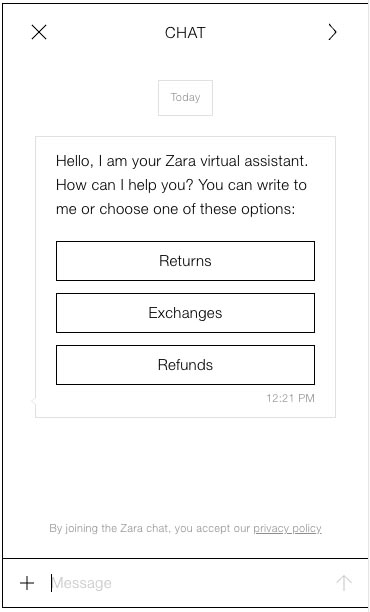
Zara’s chatbot starts with a series of questions to help identify customer problems so it can provide relevant resolutions.
Read more with our guide to retail customer service.
2. Issuing Returns & Exchanges
Another way that ecommerce businesses can use chatbots is to issue returns and exchanges. Ecommerce chatbots can give instructions for returns/exchanges, and some can even provide shipping labels and exchange suggestions.
For example, looking again at the Zara chat, if you select “Return” from the options menu it provides when you open the chat, the chatbot will tell you exactly how to facilitate a return or exchange and how to print a return label, if needed.
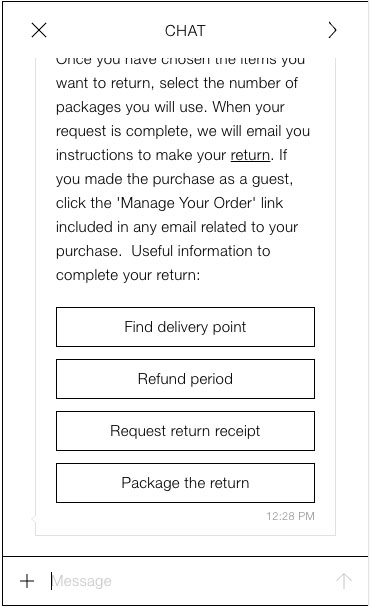
Zara offers lots of questions about your return so that it can provide you with relevant options and instructions.
3. Answering Product or Policy Questions
Another way to use chatbots in ecommerce is to provide customers with product and policy information. Say a customer is looking to buy a shirt from your online store but wants more information about shipping times because they are leaving for a trip soon. They could ask the chatbot how long shipping typically takes for their destination, and the chatbot could tell them about your shipping and handling policy.
With this automation, the information will be delivered quickly and accurately to the customer, and your staff will be able to continue working without having to field the messages. Take our example below—I returned to the Zara chatbot because I had a sizing question. Simply by selecting the “Determine my size” option I was able to get sizing information immediately.
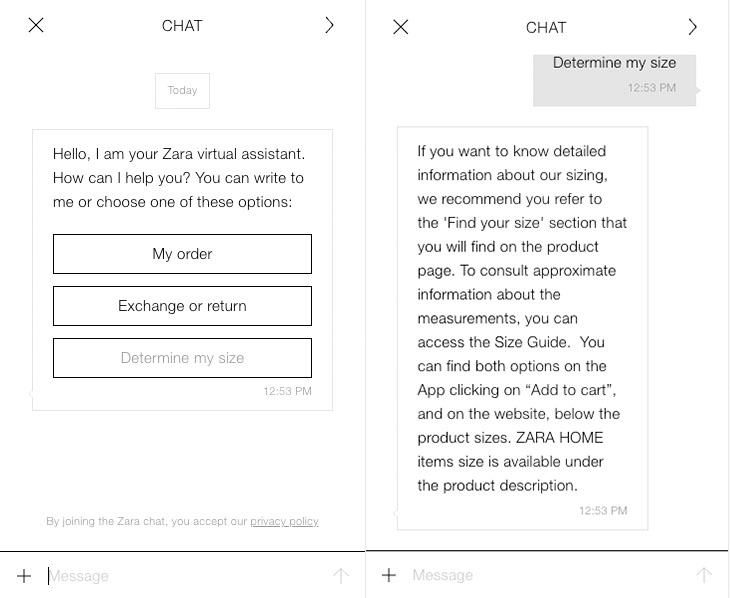
Customers can get product and policy information quickly, and you can free up your time using an ecommerce chatbot.
4. Taking a Reservation
If you have a store that hosts shopping appointments or other services that require reservations, a chatbot can be super useful for taking reservations. Many chatbot platforms come equipped with reservation management, or you can program a reservation function yourself.
From there, chatbots can walk customers through the reservation process, including selecting a service, setting a time, number of people, etc.—the information needed is up to you. Many ecommerce chatbots can also let customers cancel and update reservations
5. Joining a Loyalty Program
Another way to use ecommerce chatbots is to help customers sign up for your emails or join a loyalty program. Many ecom sites have popups to sign up for a loyalty or email program as soon as customers enter the site. But, if the customer closes that out, they might not know how to find a sign-up field again. That’s where the chatbot comes in. Customers can simply ask to sign up for emails, and the bot can redirect them to the sign-up page, as you see below with denim retailer Bluenotes.
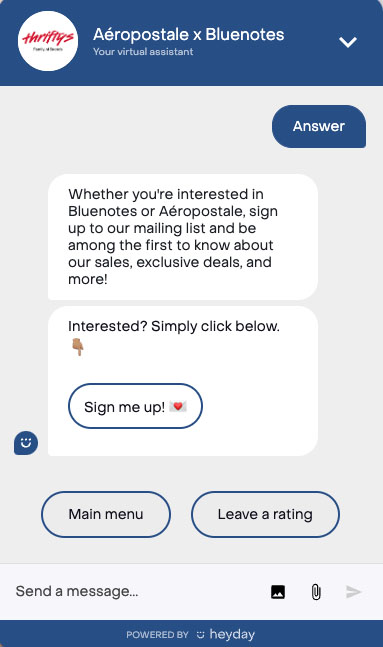
Make it easier for customers to sign up for your loyalty program and emails with a chatbot.
Read more with our guide to creating a loyalty program and the best loyalty program software.
6. Greeting Customers
You can use chatbots on ecommerce websites to greet customers and let them know that they (the bots) are there to help and answer any questions. This emulates the experience of shopping in a store, creates a welcoming environment, and lets customers know they can get their questions answered even as they browse on a screen.
For example, if you go to the fitness apparel website Gymshark, the chatbot messenger pops up, greets you, and offers help immediately. This lets customers know that the assistance is there and makes the site welcoming.
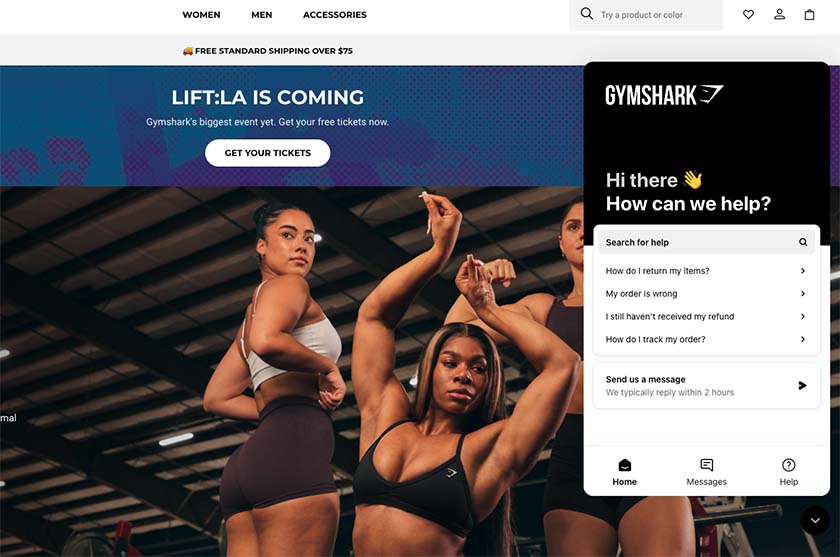
Gym Shark’s chatbot welcomes customers as soon as they enter the store.
Read more with Greeting Customers: Tips for Welcoming Shoppers to Your Store.
7. Collecting Customer Information
You can also use your chatbot to gather customer information, like emails and survey responses. You can do this either by offering a survey at the end of an interaction, prompting contact information during an exchange, or starting a conversation with a series of questions that customers have to answer before submitting a request.
Customer data can then be used for outreach marketing efforts, better understanding your target market, inventory management, and improvements to your ecommerce chatbot.
8. Driving Sales on Instagram & Facebook
An increasingly popular way people use chatbots for ecommerce is on Facebook and Instagram with their chatbot frameworks (see more on chatbot frameworks below).
This means that when a user visits your Facebook or Instagram page and sends you a message, they can get an immediate response from your brand’s chatbot. This way, customers can get the information they need and are more likely to make a purchase.
At the same time, you won’t have to spend hours monitoring your social media pages for messages and can rest assured that your shoppers are taken care of on your social sales channels. For example, if you visit the Facebook page for the WeWoreWhat clothing line and click on the message button to send them something, you are directed to a chatbot menu where you can quickly get relevant info.
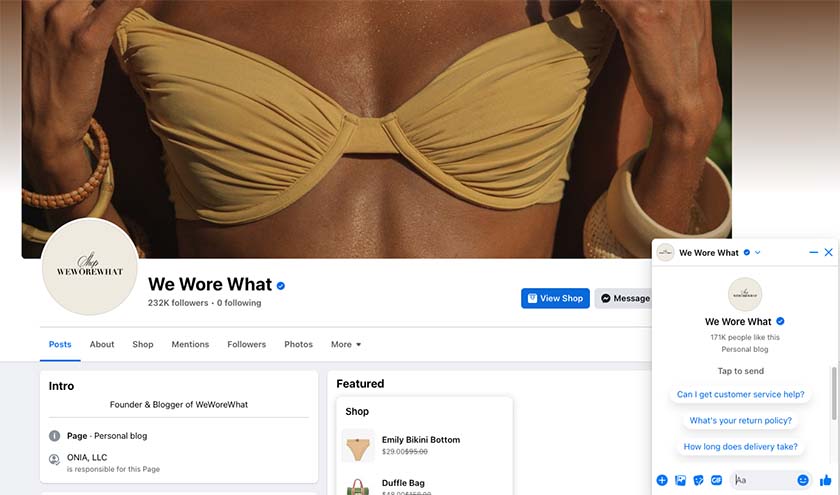
You can add chatbots to your social media pages so customers can get information quickly.
9. Preventing Abandoned Carts
Another way you can use chatbots in ecommerce is to prevent abandoned carts. Chatbots can send messages to customers reminding them of what they left behind, send discounts to incentivize the completion of a purchase, and even send images of the products customers selected in their carts.
For example, tech firm Roundview outlines how the cart abandonment messaging works in the image below. As soon as the customer leaves the cart page, the chatbot goes into action, sending reminders and then discounts to lure the customer back to complete their purchase. The chatbots effectively makes it harder for customers to abandon their cart, and the added discount incentive will help boost conversion rates.
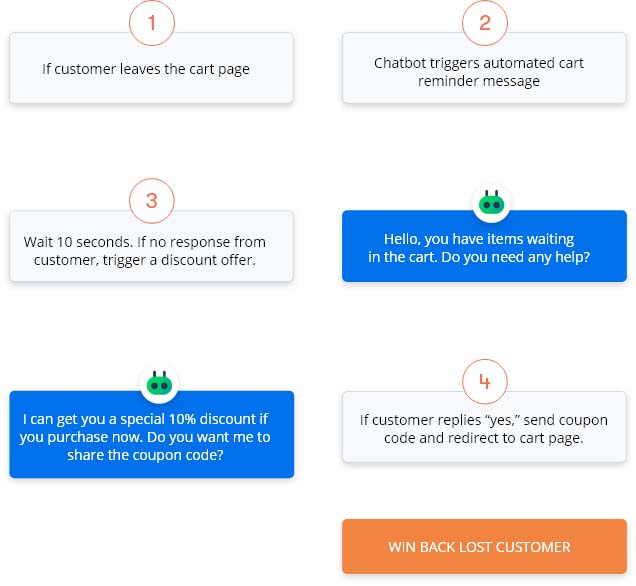
Roundview’s chatbot prompts customers back to their shopping cart to complete their purchase.
10. Upselling & Cross-Selling
Another use for ecommerce chatbots is cross-selling and upselling. Chatbots can make product recommendations and show compatible products based on customer queries. Additionally, some will even provide product recommendations based on what the customer has shown interest in, even without a prompt.
For example, with global fashion retailer H&M’s chatbot, customers can ask for outfit suggestions based on a piece they want to style.The bot will then give them other product ideas.
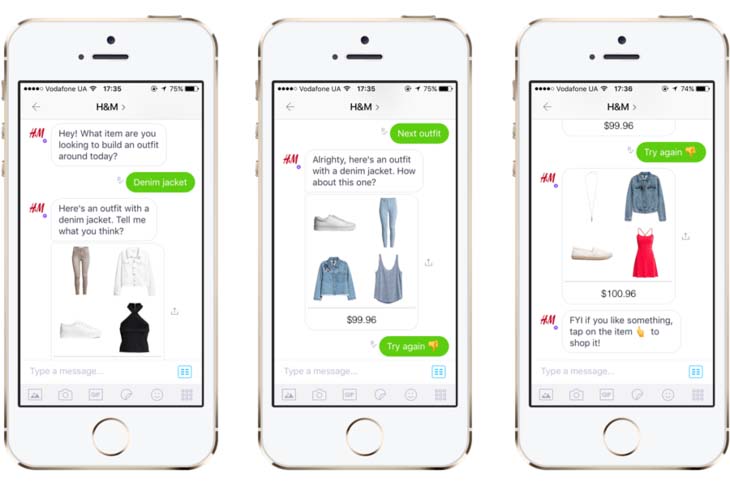
H&M’s chatbot gives styling tips that feature other H&M products the customer can buy.
Ecommerce Chatbot Pros & Cons
| PROS | CONS |
|---|---|
| Provide fast, real-time answers | Customer hesitation and perception |
| Cost effective | Customers may prefer talking to real people |
| Track customer data | May lead to decreased customer satisfaction |
| Ability to gather feedback | Higher cost for more advanced ecommerce bots |
| 24/7 availability | Limited capabilities to understand complex problems |
| Multilingual | |
| Ability to handle multiple requests at a time | |
| Help generate revenue | |
Ecommerce chatbots bring a lot to the table. They are cost-effective and can help you reduce your staffing needs, all while helping you make money.
For ecommerce, chatbots have shown to be able to solve about 58% of return and cancellation disputes without a human representative, and nearly 10% of people report having used a chatbot during their last store visit. Largely because the ecommerce chatbots are able to answer questions quickly, only about 9% of people say that companies should not use them.
So, consumers and businesses do benefit from ecommerce chatbots, but there are also some downsides to consider. Ecommerce chatbots often have issues processing complex requests. In fact, in a survey from Userlike, it reported that 60% of people who had used a chatbot said the chatbot was unable to solve their issue. Additionally, 60% of consumers still prefer working with a person and would rather wait in line for an agent than be directed to a chatbot immediately.
While you should understand the problems that come with adopting ecommerce chatbots, they should not deter you completely. Investing in a chatbot for your ecommerce store can be a smart move that doesn’t have to break the bank.
How to Add a Chatbot to Your Ecommerce Store
If you want to add a chatbot to your ecommerce store, you have two options. Either you can add a chatbot app/platform or opt for a more complex chatbot framework.
Chatbot App
With a chatbot app/platform, the messenger portal and AI are already built out, so you don’t need a developer. Instead, you simply use the app’s predesigned setup process to create a conversation flow and input responses that align with brand policies.
Some chatbot apps are rule-based and use buttons to gather responses and build conversation, while others have a more conversational flow and incorporate NLP/AI functionality.
Chatbot apps/platforms are a great option if you don’t have developer skills and want a prebuilt bot. They are typically less complex than custom-built chatbot frameworks but are great for providing policy information and resolving simple problems.
Once you have made your customization, you simply add it to your site either via an integration (recommended) or a custom API. Chatbot apps also typically include reporting tools that you can access via your chatbot platform account. Additionally, many ecommerce platforms are compatible with chatbot apps, and you can simply add them to your store without an API.
Take a look at some of the best ecommerce chatbot apps with the Top Ecommerce Chatbots for Your Business Guide.
Chatbot Framework
Alternatively, if you want a more complex or custom chatbot, you can use a chatbot framework or open-source chatbot. With a chatbot framework, rather than coding a custom chatbot from scratch (yikes), the framework comes with a collection of prebuilt tools—typically language and AI—that you can then build out with custom logic and response types using a developer. Chatbot frameworks operate using a variety of coding languages, primarily Python, Ruby, Java, PHP, and Lisp.
Chatbot frameworks are a great option if you need a chatbot that can handle more complex requests and have the developer knowledge (or budget) to build one. Additionally, major platforms—like Facebook, Google, and Amazon—provide chatbot platforms if you want to add a custom ecommerce bot to your selling pages.
A few of the top chatbot frameworks include:
- Dialogflow
- Microsoft Bot Framework
- IBM Watson
- Chatterbot
- Rasa
- Amazon Lex
Learn more about your options with the guide to The Best Open Source Chatbots.
Bottom Line
Chatbots are becoming a key part of running a successful ecommerce store. With retailers increasingly investing in the tech and consumers using (and expecting) it more and more, there is no question that ecommerce chatbots are moving toward ubiquity. With savings to be had and money to be made, it may be time to invest in an ecommerce chatbot so you can stay competitive and keep up with the ever-evolving world of retail.